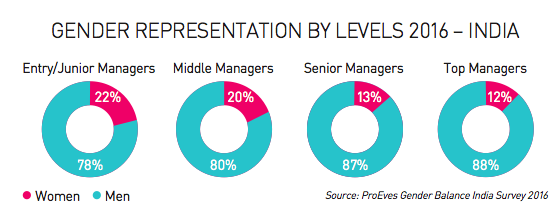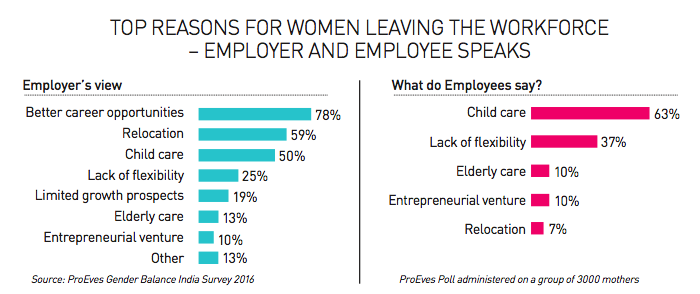Is India Inc. doing enough to move the needle on gender diversity?

With increasing realization that addressing the gender gap will deliver higher growth and development worldwide — nowhere more so than in India, ProEves launched Gender Balance India Survey 2016 to gather insights on how companies are trying to bridge this gap. Forty-seven companies across various sectors like FMCG, IT, Manufacturing, ITES, E-commerce and Financial Services participated, making this one of the largest studies on gender diversity policies and programs in India. The study goes beyond understanding the current representation across levels and addresses deeper issues around leadership accountability, enabling policies and programs that support gender balance, and consistency between what employees want and companies provide.
The survey reveals that the overall woman participation in India Inc. is stuck at 20-22%.
At the entry/junior and middle levels of management, there is 22% participation which sharply falls to 12-13% at senior and top levels which clearly points to a leaking pipeline from middle to senior levels. Companies have been in the news for introducing practices and programs to attract women and arrest this leaking pipeline. Despite good intentions and policy changes, implementation on the ground has had limited impact so far. Studies in prior years, viz. Catalyst 2015 and Community Business 2014 India Study also reveal similar representation levels. So the Gender Diversity agenda is not truly reflecting in the year on year progression of these numbers.

Only 26% of companies have a returnee program to attract women who are on breaks
Why is women representation in corporate India stagnant? Is India Inc. taking true accountability and actions?
Over 61% of companies have stated goals on diversity and 83% measure it at an organization level. However, in less than a third of companies, gender diversity is a part of leadership KRA. At the managerial level, 68% companies provide line manager sensitization training and 54% expect line managers to drive gender balance, but only 9% formally recognize managers who drive D&I in their teams. There is little incentive for managers to promote gender diversity at the ground level. Companies with a higher gender diverse representation have two common trends that could be critical for success:
- Tracking the agenda at micro entities like functions, levels, geographies, beyond just the organization level helps in identifying opportunity areas and making tangible progress.
- While business case and targets for gender diversity work, personal buy-in at the leadership level helps in moving the agenda forward faster.
Implementation at the ground level requires a strong partnership approach between business and HR teams.
How are companies attracting a gender balanced workforce?
About 83% of companies have a focused diversity hiring agenda and usually depend on search/recruitment partners to achieve this.
- 67% of companies provide unconscious bias training to hiring managers
- 38% of companies run women focused employee referral campaigns
- 26% of companies have a returnee program to attract women who are on breaks and 17% are considering launching one
Companies are leveraging available mediums like company websites, job portals, social media channels to be featured as a preferred employer for women.
While 70% of working women leave their careers citing childcare as the main reason, less than 20% of surveyed companies provide daycare support through an onsite or a multi-site tie up
Given that companies are taking proactive steps in hiring a gender-balanced workforce, why is women representation stagnant? Is female attrition contributing to the leaking bucket and wiping away progress made in hiring?
The survey takes a closer look at reasons for attrition amongst women. Better career opportunities continue to be the number 1 reason stated by employers for women quitting the organization which is gender agnostic. Relocation, childcare and lack of flexibility are other key reasons cited by employers. ProEves separately reached out to a group of 3000 moms to get an employee perspective. Childcare and lack of flexibility were the top two reasons for women leaving employers.
A recent CTI survey states that 91% of women in India who drop put because of childcare want to come back to work. What is alarming to know is that 72% of women in India do not want to go back to their previous employer for reasons like expectation and performance bias and lack of mentoring and counseling support. Only 26% companies have a returnee program to attract women who are on a career break.
The next logical question is what are the some of the enablers with respect to childcare, maternity and parental support that companies are providing to retain a gender balanced workforce?
Working parents comprise a large percentage of the employee workforce with an average age of 29 years. This year has been a landmark year with companies participating in the UN Campaign "He for She" and voicing opinions on maternity and paternity benefits. Providing parental support is an important part of the inclusion charter for companies. Companies have a dedicated parental employee resource group and engage with them by providing meaningful childcare and parental support.
It is important for companies to provide holistic support to expecting mothers throughout the parenting life-stage
Childcare Support: While 70% of working women leave their careers citing childcare as the main reason, less than 20% of surveyed companies provide daycare support through an onsite or a multi-site tie up. Almost 66% of the companies currently do not provide any childcare support. Most of these companies would have to act fast with the recent amendments to the Maternity Benefits Act. More companies need to provide for this benefit not only to moms but all working parents.
Maternity Support: When it comes to providing maternity support, companies are looking at tangible benefits being provided either within their sector or industry at large and extending feasible benefits to their employees.
- 54% of companies provide 6 months or more of maternity leave. This is in line with the amendments to the Maternity Benefits Act, 1961
- 89% of companies provide medical entitlement greater than Rs. 50,000 for maternity

It is important for companies to provide holistic support to expecting mothers throughout the parenting life-stage. Engagement with the line manager, skip level manager/mentor and HR business partner is an important aspect of providing support.
- 46% of companies provide pre-maternity connect with skip level manager/mentor to understand any work apprehensions that the employee may have while she is on leave and reinforce the organization’s commitment to providing support to ensure smooth transition to parenthood.
- 51% of companies ensure mid-maternity connect with HR Business partner and/or the Line manager to understand return plans and make the employee feel valued.
- When it comes to post maternity connect, only 26% of companies engage in skip level manager/mentor connect.
With women showing high joining back urgency and high current employer aversion, it is important that companies invest in post maternity connect to help women ramp back smoothly and clear any biases that the team may have and understand their flexibility requirements. This real gender fix is not maternity leave but post maternity integration.
Do employer's policies match the needs of the employees?
The findings with regards to gender representation prompted a question, whether corporate India is doing the right things to promote women participation across levels? To validate this. we reached out to around 3000 women in the ProEves managed online community ‘Happy Moms Raise Happy Kids’. We asked employers the top enablers they provided for increasing women participation and asked women what they wanted from employers and this clearly revealed gaps in terms of both policy design and implementation.
While 74% of surveyed employers believe that they provide flexibility as a key enabler and 68% of women desire flexible work arrangements — lack of flexibility is still cited as a key reason for attrition. This implies that while flexible working policies are prevalent, they are not really adopted and employees shy away from using such arrangements. Leaders need to embrace flexi-working as a ‘business as usual’ practice to set an example for their colleagues down the line.
Around 93% of surveyed women want a month of paternity leave for their spouses to support them through this transition, which is something that both India Inc. and the government should reflect on whether it is possible to drive Gender Diversity by focusing just on women. Real progress on gender diversity will be seen if companies address the exact reasons for leaking pipeline which is childcare and post maternity support and creating an ecosystem where leaders, line managers and employees (80% of who are men) are diversity and inclusion cheerleaders.











